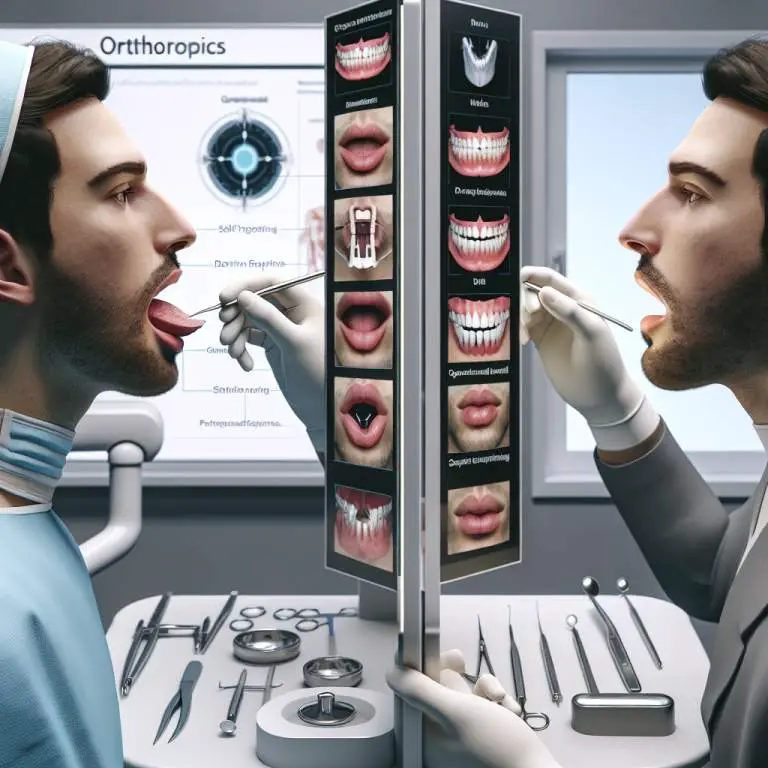Can mewing offer similar benefits to chin fillers or implants?
Mewing, a technique that involves proper tongue posture to potentially reshape the jawline, cannot offer the same immediate or dramatic results as chin fillers or implants. While mewing may lead to subtle changes over time by encouraging correct jaw alignment, fillers and implants provide quick and noticeable enhancements to the chin’s appearance. Therefore, mewing cannot be considered a direct substitute for these cosmetic procedures.

How Does Mewing Work and What Are Its Purported Benefits?
Mewing is a technique that involves placing your tongue against the roof of your mouth. This position is supposed to help with the way your jaw and face look. People say that by doing this, you can make your jawline sharper and your face more attractive.
The idea behind mewing comes from thinking about how muscles work in our bodies. Just like lifting weights can make your arms stronger, mewing is supposed to strengthen the muscles in your face. Some people believe it can even help with breathing problems or stop snoring at night.
Can Mewing Actually Change the Shape of Your Face?
Many people wonder if mewing can really change how their face looks. The truth is, it’s a bit complicated. While some folks share stories about how mewing reshaped their faces, scientists haven’t proven these changes happen for everyone.
It’s important to remember that everyone’s body reacts differently to things. So, while one person might see changes from mewing, another person might not notice anything different. It seems like more research needs to be done to understand who can benefit from mewing and how much it can do.
What Are the Differences Between Mewing and Chin Fillers or Implants in Terms of Results?
Mewing and chin fillers or implants are two ways people try to change their jawlines, but they’re pretty different. Chin fillers or implants involve going to a doctor who adds special materials under your skin or puts in an implant to make your chin look a certain way. It’s a quick way to see changes.
On the other hand, mewing is all about using your own muscles over time to potentially reshape your face naturally. There’s no surgery involved with mewing, but it also means results might take longer to show up—if they do at all. So, if someone wants fast results, they might choose fillers or implants over mewing.
How Long Does It Take to See Results from Mewing Compared to Fillers or Implants?
If you’re thinking about trying mewing, you might be wondering how long before you see any changes. Well, because mewing relies on gradually training muscles and possibly shifting bones slightly, it can take months or even years before noticing anything different. And for some people, there may never be visible results.
In contrast, chin fillers or implants offer immediate changes since they physically alter the shape of your chin right away during the procedure. After recovery from surgery or injections—which could take a few days to weeks—you’ll see the new shape of your chin. So when comparing speediness of results, fillers or implants win over mewing.
<
<| Enhancement Method | Description | Expected Results | Duration of Results | Risks/Side Effects |
|---|---|---|---|---|
| Mewing | A technique that involves proper tongue posture to potentially reshape the jawline and facial structure. | Subtle changes in jawline and facial structure over time. | Permanent with continuous practice. | Minimal to none, but effectiveness and safety not widely studied or confirmed. |
| Fillers (e.g., Hyaluronic Acid) | Injections that add volume to soft tissues, used in lips, cheeks, and under-eye areas. | Immediate enhancement of treated areas. | 6 months to 2 years, depending on the type of filler used. | Bruising, swelling, asymmetry, risk of infection. Rarely, vascular occlusion leading to tissue death or blindness. |
| Implants (e.g., Chin or Cheek) | Surgically placed implants designed to enhance or augment the physical structure of the face. | Lasting structural changes to the enhanced area. | Permanent unless surgically removed or revised. | Infection, shifting of implant over time, dissatisfaction with results, anesthesia risks. |
Are There Any Risks Associated with Mewing as Opposed to Surgical Options?
Mewing, a technique that involves proper tongue posture, is seen as a low-risk method for potentially enhancing facial structure. Unlike surgical options, mewing doesn’t involve incisions, anesthesia, or a recovery period. This makes it an appealing alternative for those wary of the risks associated with surgery.
However, experts caution that incorrect mewing techniques could lead to jaw pain or misalignment. It’s important to research and understand the correct posture before attempting mewing. In contrast, surgical options like chin fillers or implants carry risks such as infection, allergic reactions, and dissatisfaction with aesthetic outcomes.
What Do Experts Say About the Efficacy of Mewing Versus Cosmetic Procedures?
Many experts remain skeptical about the efficacy of mewing when compared to established cosmetic procedures. They argue that while mewing might promote better oral posture and potentially minor aesthetic improvements, it cannot replicate the significant changes achievable through cosmetic surgery or fillers.
On the other hand, some professionals acknowledge that mewing can contribute positively to facial health by encouraging proper tongue placement and breathing patterns. They suggest that while mewing may not replace cosmetic procedures for those seeking dramatic results, it could serve as a complementary practice for overall facial wellness.
Can Mewing Provide Permanent Results Similar to Those of Chin Fillers or Implants?
The permanence of results from mewing is a topic of debate among both practitioners and individuals who have tried the technique. Proponents claim that consistent and correct practice over time can lead to permanent changes in facial structure due to the remodeling of bone and muscle tissue.
In contrast, chin fillers offer temporary enhancements that typically last from 6 months to 2 years depending on the type used. Implants provide a more permanent solution but come with higher risks and costs. Therefore, while mewing might offer gradual and subtle improvements over time without financial cost or medical risks, it does not guarantee the immediate or dramatic results that surgical options do.
Final Thoughts
Mewing presents an intriguing option for individuals interested in potentially improving their facial aesthetics without undergoing surgery. Its low-risk nature makes it accessible to many people who are hesitant about more invasive procedures.
Nevertheless, it’s crucial to maintain realistic expectations regarding what mewing can achieve compared to surgical alternatives like chin fillers or implants. Consulting with healthcare professionals can provide guidance tailored to individual needs and goals. Ultimately, whether one chooses mewing or cosmetic procedures depends on personal preferences regarding risk, cost, and desired outcomes.






